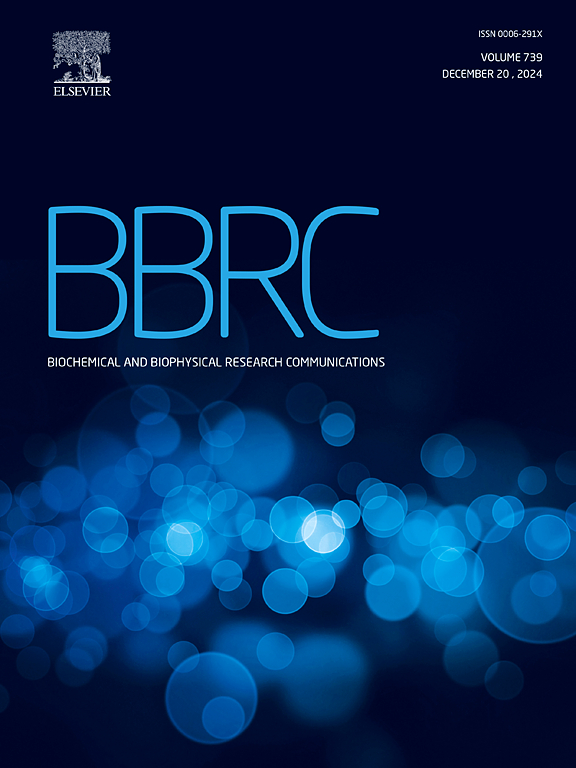Bioinformatics analysis reveals the diagnostic and therapeutic value of the centrosome replication-related gene SPICE1 in keloid
IF 2.5
3区 生物学
Q3 BIOCHEMISTRY & MOLECULAR BIOLOGY
Biochemical and biophysical research communications
Pub Date : 2025-04-01
DOI:10.1016/j.bbrc.2025.151743
引用次数: 0
Abstract
Keloids are the abnormal accumulation of collagen in the dermis, which leads to the formation of raised fibrous tissue at the site of injury and the development of a hard scar. The underlying pathological mechanisms associated with keloids have not been fully elucidated. In this study, two GEO datasets (GSE44270 and GSE7890) were employed alongside two machine learning algorithms, Support Vector Machine-Recursive Feature Elimination (SVM-RFE) and Random Forest, to identify diagnostic biomarkers associated with centrosome replication. Following identifying these biomarkers, researchers conducted a functional enrichment analysis to elucidate their biological significance and constructed a gene regulatory network to map their interactions. Furthermore, the study investigated the role of SPICE1 in keloid formation, utilizing a mouse model to explore its potential implications in this pathological process. Researchers identified ten diagnostic markers associated with centrosome replication, among which SPICE1 was significantly upregulated in keloid tissues and fibroblasts. In vivo experiments further demonstrated that the overexpression of SPICE1 promotes keloid formation. Additionally, functional enrichment analysis revealed a connection between these markers and immune cells, suggesting that the immune system may play a crucial role in the development of keloids. This study indicates that SPICE1 is a potential diagnostic marker and therapeutic target for keloids. It offers new insights into the pathological mechanisms of keloids and the development of novel treatments.
生物信息学分析揭示了中心体复制相关基因SPICE1在瘢痕疙瘩中的诊断和治疗价值
瘢痕疙瘩是指真皮中胶原蛋白的异常积累,导致损伤部位纤维组织凸起,形成坚硬的疤痕。与瘢痕疙瘩相关的潜在病理机制尚未完全阐明。在这项研究中,两个GEO数据集(GSE44270和GSE7890)与两种机器学习算法(支持向量机递归特征消除(SVM-RFE)和随机森林)一起使用,以识别与中心体复制相关的诊断性生物标志物。在确定这些生物标志物之后,研究人员进行了功能富集分析以阐明它们的生物学意义,并构建了基因调控网络以绘制它们之间的相互作用。此外,本研究还研究了SPICE1在瘢痕疙瘩形成中的作用,利用小鼠模型探索其在这一病理过程中的潜在意义。研究人员发现了10个与中心体复制相关的诊断标记,其中SPICE1在瘢痕疙瘩组织和成纤维细胞中显著上调。体内实验进一步证明SPICE1的过表达促进瘢痕疙瘩的形成。此外,功能富集分析揭示了这些标记物与免疫细胞之间的联系,表明免疫系统可能在瘢痕疙瘩的发展中发挥关键作用。本研究提示SPICE1是瘢痕疙瘩潜在的诊断标志物和治疗靶点。它为瘢痕疙瘩的病理机制和新治疗方法的发展提供了新的见解。
本文章由计算机程序翻译,如有差异,请以英文原文为准。
求助全文
约1分钟内获得全文
求助全文
来源期刊
CiteScore
6.10
自引率
0.00%
发文量
1400
审稿时长
14 days
期刊介绍:
Biochemical and Biophysical Research Communications is the premier international journal devoted to the very rapid dissemination of timely and significant experimental results in diverse fields of biological research. The development of the "Breakthroughs and Views" section brings the minireview format to the journal, and issues often contain collections of special interest manuscripts. BBRC is published weekly (52 issues/year).Research Areas now include: Biochemistry; biophysics; cell biology; developmental biology; immunology
; molecular biology; neurobiology; plant biology and proteomics

 求助内容:
求助内容: 应助结果提醒方式:
应助结果提醒方式:


